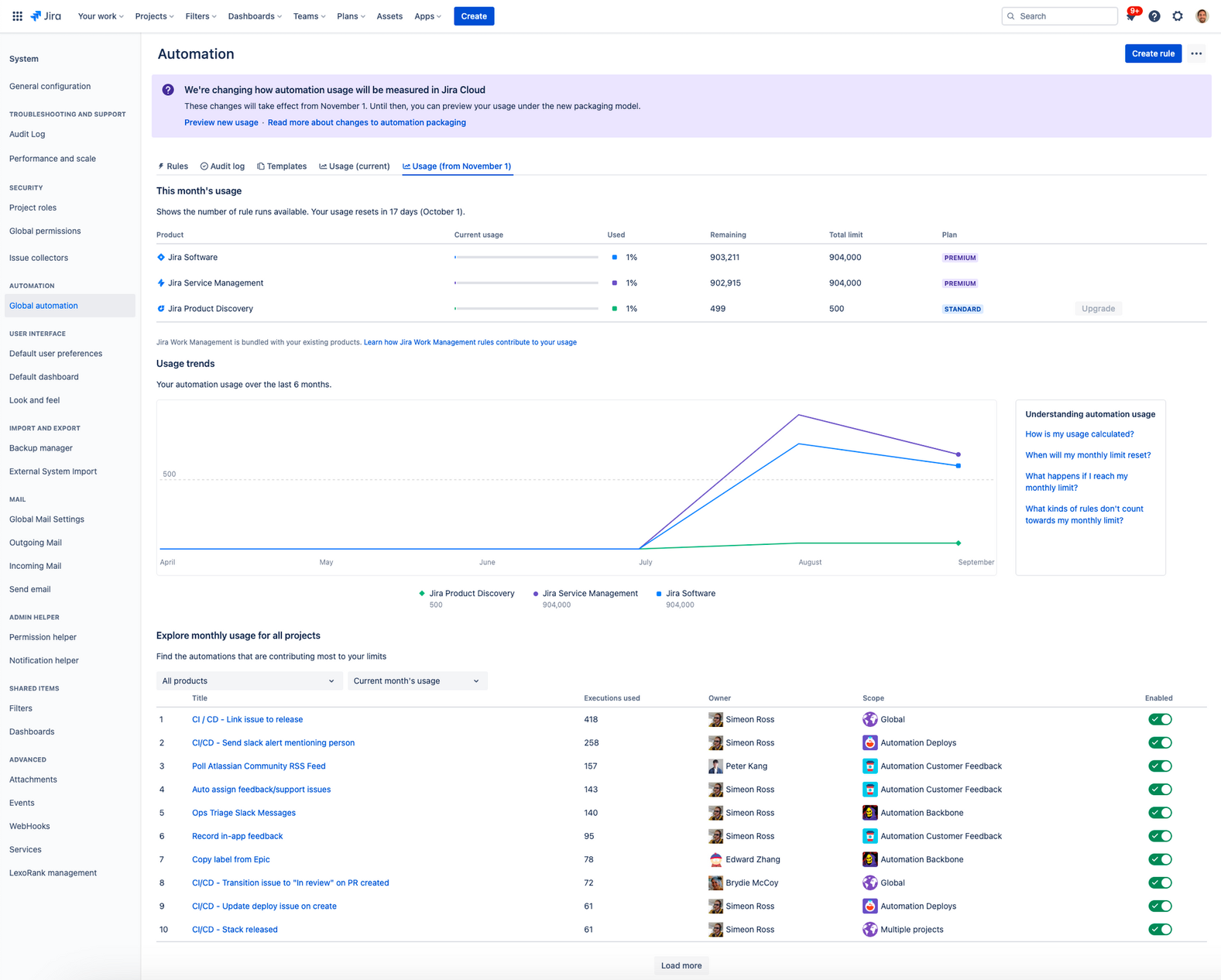Changes to our Automation packaging model for Jira Cloud
Here’s what’s changing and how we’re supporting affected customers.
Automation is a critical tool teams use to accelerate productivity with the help of Atlassian’s cloud products. Since 2020, we have made steady investments in this area, integrating Automation as a core component of Jira Software, Jira Service Management, Confluence, Jira Product Discovery, and Jira Work Management, as well as introducing new templates and integrations, including those with AWS and Azure.
We’ll continue to invest in bringing Automation to more products, and add support for more integrations so customers can expand the use of automation across their toolchain. To better support this investment, we are changing our packaging to introduce new limits that provide a more scalable model that works consistently across our products and is better aligned with industry standards.
On November 1, 2023 we are launching a new Automation packaging model for all Jira Cloud products (Jira Software, Jira Service Management, Jira Work Management, and Jira Product Discovery).
This update will cover:
- The differences between the current and future packaging, and how long customers have to plan
- Approximately how many customers will be affected by the change
- The help we are offering to affected customers to ease the transition
What is changing in our Jira Cloud Automation model?
First, here are the key differences between today’s Automation packaging model and the new model:
| In the current packaging model | In the new packaging model |
|---|---|
| All Automation rule runs are aggregated as a single limit across all of your Jira Cloud licenses. | Each Jira Cloud product will have its own limit and will be measured per product license. |
| Any rule that is triggered, regardless of whether the action is successful, counts towards your limit. | Only rules that result in a successful action will count towards your limit. |
| • Project-type, multi-project, or global rules count towards your limit. • Single-project rules are unlimited and don’t count towards your limit. • Actions (log action, create lookup table, create variable, refetch issue, and look up issues) count toward your limit. | • Single-project, project type, multi-project, or global rules will count towards your limit. • Actions (log action, create lookup table, create variable, refetch issue, and look up issues) don’t count toward your limit. |
In today’s model, customers get a single, pooled limit across all Jira Cloud products. For example, if a customer has Jira Software Standard and Jira Service Management Free, they would get a total of 600 Automation rule runs per month (500 from Jira Software Standard and 100 from Jira Service Management Free) that can be used across both products.
In the new model, each Jira Cloud product will have its own usage limit. Every Automation rule will draw on the limit of a specific product when it runs. We have increased the limits for our Free and Standard plans to account for this. Automation limits in the new model are shown in our support page here.
How customers are affected and resources to help them
Next, we want to share that the above changes will affect fewer than 5% of Jira Cloud Free, Standard, and Premium Edition customers. All customers will receive a notice by email by October 2, 2023 indicating whether or not they will exceed limits under the new model.
- Customers on annual subscriptions will not have the new limits enforced until their next renewal quote creation date.
- Jira Cloud Standard edition customers who are currently projected to breach limits under the new model will receive a 3-month trial of Premium at the price of Standard that begins November 1, 2023, allowing up more time to adjust to the new limits.
Additionally, we are introducing an enhanced usage tab within the Jira admin console so you can view and adjust the monthly Automation usage for your organization under the new model:

If the new usage tab shows that your Automation usage is exceeding the new limits, we recommend looking at your current rules and optimizing them. Here are some things you can do:
- Configure your rules to run where they need to: Make sure your rule runs only in the Jira projects (or Confluence spaces) you want it to run in.
- Add conditions to your Automation rules: Ensure that actions occur exactly when you want them to in order to maximize the value you get out of your rules.
- Disable rules: Monitor your rules and identify the ones that are either running too often or that you don’t need, and disable them to prevent wasteful rule runs.
To learn more about how to view your Automation usage and how your usage is calculated, please see the following articles: View your Automation usage and How is my usage calculated? If you still have questions or concerns about these changes, you can contact us directly.


